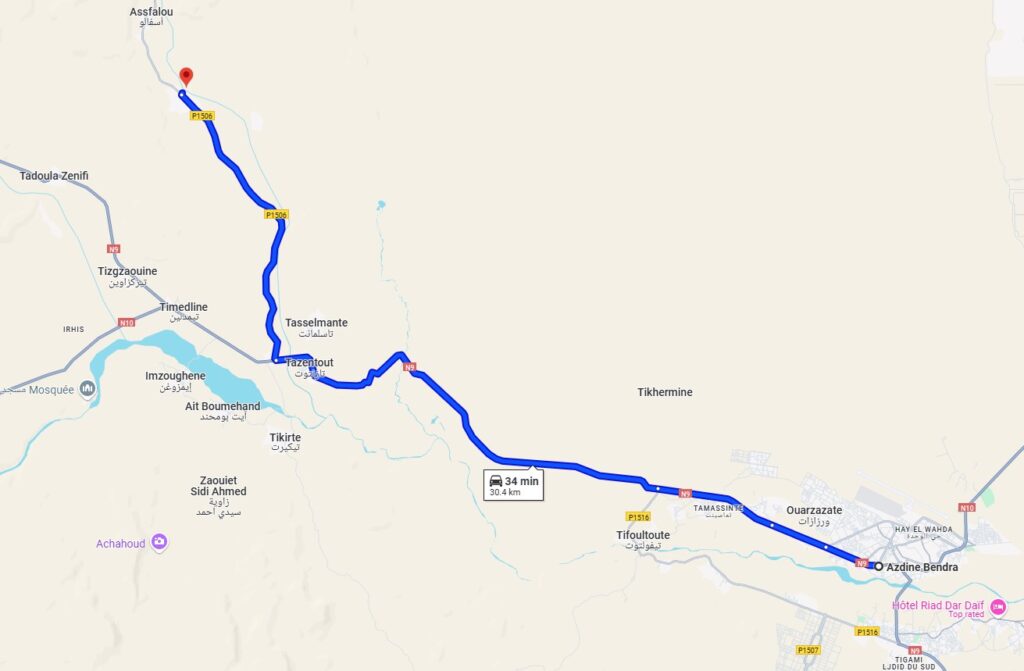Ait Benhaddou Morocco is one of the country’s most breathtaking and historically rich destinations. This ancient fortified village, nestled near the High Atlas Mountains, is a UNESCO World Heritage Site known for its mud-brick architecture, cultural heritage, and cinematic fame. Whether you’re drawn by history, photography, or iconic film locations, Ait Benhaddou offers a unique glimpse into Morocco’s timeless beauty.
Table of Contents
Historical Significance of Ait Benhaddou Morocco

Located just 30 kilometers from Ouarzazate, Ait Benhaddou Morocco was once a thriving stop on the trans-Saharan trade route connecting Marrakech to the Sahara. Built in the 17th century, this ksar (fortified village) served as a crucial hub for caravans transporting gold, salt, ivory, and spices.
Although its commercial role has faded, the historical essence of the village remains intact. Visitors today walk the same paths once traveled by ancient merchants, gaining insight into the Berber way of life and the legacy of cultural exchange in southern Morocco.
Architecture and Design of Ait Benhaddou
The architectural charm of Ait Benhaddou Morocco lies in its authenticity. Constructed entirely with traditional mud-brick techniques, the ksar is a stunning example of southern Moroccan architecture. The village is enclosed by high defensive walls, with corner towers built for protection.
Key features include:
- Mud-Brick Construction: Buildings are made from clay, straw, and water, shaped into bricks and sun-dried.
- Narrow Alleyways: A maze of passageways leads through homes, courtyards, and communal spaces.
- Granary at the Summit: From the top of the village, visitors enjoy panoramic views of the Ounila Valley and Atlas Mountains.
This blend of function and beauty has helped preserve the site’s unique character for centuries.
Ait Benhaddou Morocco on the Big Screen
The dramatic setting and timeless appearance of Ait Benhaddou Morocco have made it a favorite filming location for international cinema. Its mud-brick walls and desert backdrop provide the perfect scene for epic historical dramas and fantasy series.
Major productions filmed here include:
- Game of hrones
- Gladiator
- Lawrence of Arabia
- The Mummy
- Kingdom of Heaven
Walking through Ait Benhaddou feels like stepping onto a movie set. Its cinematic legacy adds another layer of wonder to the visitor experience, attracting both film fans and casual travelers alike.
What to Do in Ait Benhaddou
While the beauty of Ait Benhaddou Morocco is undeniable, there’s more to experience than just its scenery. Visitors can immerse themselves in the culture, history, and local life with a variety of activities:
1. Explore the Ksar
Wander through narrow alleys, ancient homes, and courtyards. Each corner reveals traditional architecture and a glimpse into Berber life.
2. Climb to the Granary
Hike to the hilltop granary for spectacular views of the surrounding valleys, riverbeds, and Atlas Mountains.
3. Visit the Local Mosque
Discover the spiritual side of Ait Benhaddou by visiting the small mosque still used by locals.
4. Shop Local Crafts
Support artisans by browsing market stalls for pottery, woven rugs, and handmade souvenirs.
5. Join a Guided Tour
Enrich your visit with a guided tour. Local guides share stories and insights that deepen your appreciation of the site’s heritage and role in Moroccan history.
Why Visit Ait Benhaddou Morocco
A trip to Ait Benhaddou Morocco is more than just sightseeing—it’s a journey through centuries of culture, architecture, and tradition. From its origins as a bustling trade stop to its status as a cinematic icon, the kasbah tells a story that captivates every visitor.
Whether you’re fascinated by history, inspired by film locations, or drawn to authentic cultural experiences, Ait Benhaddou offers all of that and more. Its preserved structures, welcoming local community, and unforgettable views make it one of Morocco’s true treasures.
It’s the kind of destination that stays with you long after your visit ends.
Plan Your Visit to Ait Benhaddou Morocco
PPlanning a visit to Ait Benhaddou Morocco is simple and rewarding. The village is easily accessible from major cities like Marrakech, Fes, and Ouarzazate, and can be included in most desert tour itineraries.
Here’s how to make the most of your visit:
- Join a Morocco Desert Tour: Many Morocco tours include a stop at Ait Benhaddou, allowing you to explore the kasbah along with other stunning sites like Merzouga and the Dades Valley.
- Best Time to Visit: Spring (March–May) and autumn (September–November) offer pleasant temperatures and fewer crowds.
- Travel Tips: For practical travel advice, cultural etiquette, and safety tips, don’t miss our guide: Top 10 Tips for Visiting Morocco in 2025.
- What to Bring: Comfortable shoes for climbing, plenty of water, and your camera—every corner is a photo opportunity.
Don’t miss the chance to walk through Morocco’s most iconic kasbah. Ait Benhaddou is a destination that combines history, beauty, and cinematic charm into one unforgettable experience.
What is Ait Benhaddou Morocco known for?
Ait Benhaddou Morocco is known for its UNESCO World Heritage status, traditional mud-brick architecture, and its appearance in famous films like Gladiator and Game of Thrones. It’s one of the most iconic kasbahs in the country.
Where is Ait Benhaddou located?
Ait Benhaddou is located in southern Morocco, about 30 kilometers from the city of Ouarzazate, near the foothills of the High Atlas Mountains.
Is Ait Benhaddou worth visiting?
Yes, Ait Benhaddou is absolutely worth visiting. It offers a unique blend of cultural history, stunning architecture, panoramic views, and cinematic charm—all in one destination.
How do you get to Ait Benhaddou from Marrakech?
You can reach Ait Benhaddou from Marrakech by car or guided desert tour. The drive takes about 4–5 hours through the scenic Tizi n’Tichka mountain pass.
How long should I spend in Ait Benhaddou?
A half-day visit is enough to explore the kasbah, but a full-day trip or overnight stay allows you to enjoy the views, shop local crafts, and experience the site with fewer tourists.
